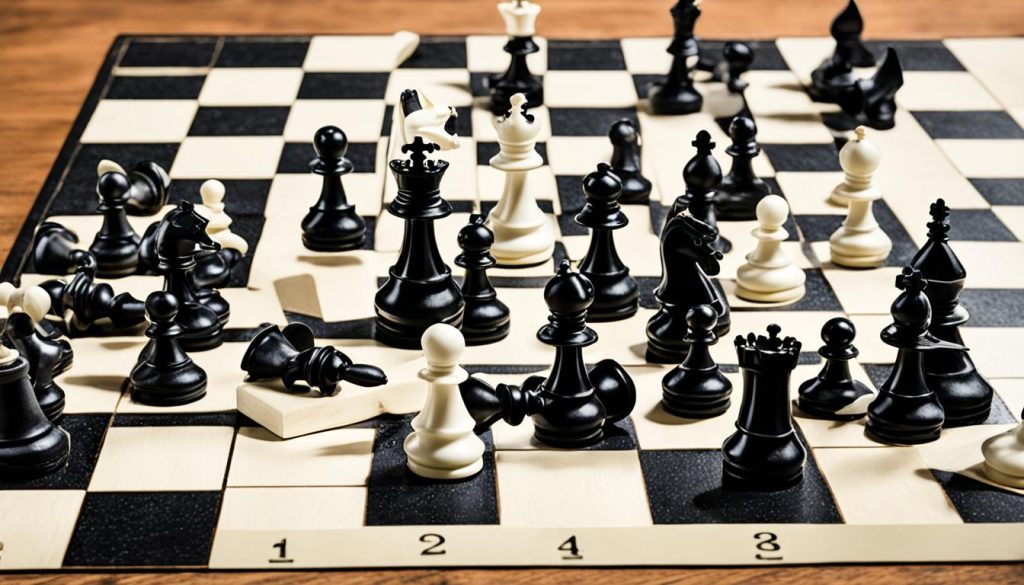Can you imagine if there was a way to defeat your opponent after just four moves? It turns out that this is a possibility in chess, and it is known as the Scholar’s Mate. This article will teach you how to execute the Scholar’s Mate, one of the fastest checkmates in chess, and how to defend against it. You’ll also learn other key chess strategies and fundamentals to improve your game.
How to Win Chess in 4 Moves? – Scholar’s Mate
The Scholar’s Mate is one of the most well-known checkmating patterns among chess players to improve your chess gameplay. It ends the game after only four moves by attacking the weak f7-pawn with a bishop and a queen. The f7-pawn is considered weak because it is solely defended by the king, and for this reason it is a common target in many opening traps.
The Scholar’s Mate Explained
Like the Fool’s Mate, the Scholar’s Mate is one of the fastest ways a player can checkmate their opponent in chess. It is rare to see intermediate or advanced players attempting this attack since it is easy to defend against and can lead to a worse position if it fails.
One of the Fastest Checkmates in Chess
The Scholar’s Mate is a popular opening trap that can catch unsuspecting beginners off guard. Its simplicity and speed make it an attractive option, especially in fast-paced games.
Even Grandmasters Attempt It
However, even professional players sometimes try to use the Scholar’s Mate, especially in fast time-controls. Garry Kasparov and Magnus Carlsen, two of the greatest chess grandmasters of all time, have both been known to attempt this opening on occasion, demonstrating its enduring appeal in the world of competitive chess.
How to Defend Against the Scholar’s Mate?
If you are familiar with the Scholar’s Mate and you notice your opponent is trying to use it against you, it is quite easy to defend against it. There are three main options to avoid falling victim to it:
Move the Pawn to g6
Moving the pawn to g6 frees up the g7-square for the bishop to fianchetto and puts pressure on the white queen, making it more challenging for your opponent to execute the Scholar’s Mate.
Bring Out the Queen to e7
Moving the queen to e7 protects the f7-pawn, develops the queen, and adds another defender to the e5-pawn, effectively neutralising the Scholar’s Mate attack.
Defend with the Queen on f6
Placing the queen on f6 also defends against the mating threat, but it does expose the queen to potential attacks. This option should be considered carefully, as it may lead to a more complex position.
Common Traps to Avoid
When defending against the Scholar’s Mate, it is essential not to fall for some common traps that can lead to a swift defeat. Staying vigilant and understanding the various defensive options will help you navigate these situations successfully.

Controlling the Centre
Controlling the centre squares is crucial in chess, as it allows you to attack from the middle of the board and restrict your opponent’s mobility. There are two main strategies for controlling the centre: the Supported Middle Strategy and the Using the Flanks Strategy.
Supported Middle Strategy
The Supported Middle Strategy involves establishing a strong pawn structure in the centre, typically with pawns on c4, d4, e4, and f4. This creates a solid foundation for your pieces to operate from and limits your opponent’s ability to advance in the centre. By placing your pawns on these central squares, you can then develop your pieces to support and reinforce the centre, making it harder for your opponent to break through. This strategy is often employed by chess opening traps and is a popular choice among players who favour a more positional style of play.

Using the Flanks Strategy
The Using the Flanks Strategy, on the other hand, focuses on controlling the side of the board, known as the flanks. This approach involves pushing pawns on the queenside (a, b, and c files) or the kingside (f, g, and h files) to create weaknesses in your opponent’s position. By controlling the flanks, you can then manoeuvre your pieces to attack and undermine your opponent’s centre, forcing them to respond to your threats. This strategy is often used by players who prefer a more dynamic and aggressive style of play, and it is commonly seen in everyman chess publishers openings and publications.

Piece Development and Castling
Once you’ve made your opening moves, it’s important to focus on developing your pieces and getting them off their starting squares. The more pieces you can develop, the more threats you can create for your opponent. This is a crucial aspect of the game known as piece development, and it’s one of the fundamental principles of winning at chess in 3 moves.
Develop as Many Pieces as Possible
Developing your pieces means moving them to active squares where they can control the centre and put pressure on your opponent’s position. Aim to get your knights and bishops out quickly, as these pieces can be very powerful when placed on good squares. Avoid leaving your pieces on their starting squares, as they are often less effective there.
Castling Explained
Another important aspect of piece development is castling. Castling is a special move that allows you to move your king to safety and activate your rook at the same time. To castle, your king and rook must be on their original squares, and there must be no pieces between them. Castling is a great way to get your king to safety and prepare your position for an attack.
By focusing on piece development and castling, you can create a strong, coordinated position that will give you the best chance of win in 4 steps. Remember, the more pieces you can get into the game, the more threats you can create for your opponent.
Piece Values and Material Advantage
In the game of chess, each piece has a relative value, with pawns being the least valuable (1 point) and the queen being the most valuable (9 points). Maintaining a material advantage over your opponent, i.e., having more valuable pieces on the board, can be a significant factor in winning games.
Renowned chess grandmasters like Garry Kasparov and Magnus Carlsen have often employed strategic chess opening traps and tactics to gain a material advantage, such as the infamous Scholar’s Mate and Fool’s Mate. These quick checkmates, though risky, can be effective against less experienced players who are unfamiliar with the legal chess moves and chess strategy guides needed to counter them.
Ultimately, understanding the relative value of chess pieces and maintaining a material advantage are crucial elements of winning how to win chess in 4 moves and other chess games. By mastering these fundamentals, along with other strategic concepts, you can elevate your chess strategy and become a more formidable player, whether you’re a beginner or seeking to emulate the success of chess legends like those published by Everyman Chess publishers.
Conclusion
In this article, you’ve learned about the Scholar’s Mate, one of the fastest checkmates in chess. You now know how to execute this 4-move checkmate, as well as how to defend against it. Additionally, you’ve gained insights into other key chess strategies and fundamentals, such as controlling the centre, piece development, and the importance of material advantage.
Whether you’re a beginner looking to master the basics or an experienced player seeking to refine your chess tactics and chess strategies, this article has provided you with a solid foundation to improve your game. Remember, chess is a complex and captivating game, and there’s always more to learn. Keep practising, exploring new chess openings, and challenging yourself with chess puzzles and rapid chess to become a true chess grandmaster.
The journey to mastering chess is an ongoing one, but with the knowledge you’ve gained here, you’re well on your way to winning more short chess games and blitz chess matches. Embrace the challenge, enjoy the process, and let your passion for this timeless game guide you to new heights of chess success.
FAQ
Can grandmasters also attempt the Scholar’s Mate?
Yes, even professional players sometimes try to use the Scholar’s Mate, especially in fast time-controls, though it is considered risky and can backfire if the opponent knows how to counter it.
How can I test my skills in executing and defending against the Scholar’s Mate?
The article provides two puzzles – one to deliver the Scholar’s Mate, and another to defend against the attack. Solving these puzzles can help you check if you are ready to handle this type of position when playing chess.
What is the name of the 4-move checkmate?
The 4-move checkmate is known as the Scholar’s Mate, one of the fastest checkmates in chess.






